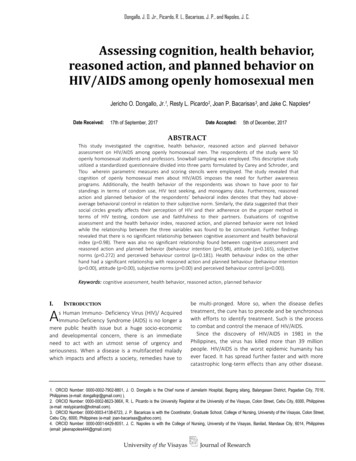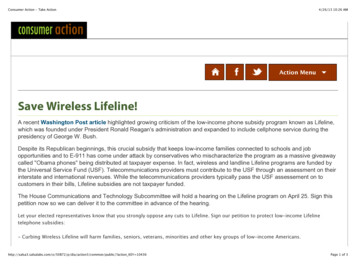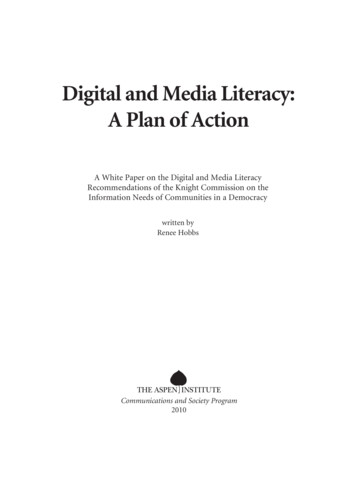
Transcription
See discussions, stats, and author profiles for this publication 824Theory of reasoned action, theory ofplanned behavior, and the integratedbehavior modelChapter · January 2008CITATIONSREADS11727,9235 authors, including:Daniel MontanoDanuta KasprzykUniversity of Washington SeattleUniversity of Washington Seattle86 PUBLICATIONS 3,538 CITATIONS47 PUBLICATIONS 1,704 CITATIONSSEE PROFILESEE PROFILEAll content following this page was uploaded by Daniel Montano on 04 July 2014.The user has requested enhancement of the downloaded file.
Glanz.ffirs7/2/0811:22 AMPage iiiHEALTHBEHAVIORANDHEALTHEDUCATIONTheory, Research,and Practice4TH EDITIONKAREN GLANZBARBARA K. RIMERK. VISWANATHEditorsForeword by C. Tracy Orleans
Glanz.ffirs7/2/0811:22 AMPage ii
Glanz.ffirs7/2/0811:22 AMPage iHEALTHBEHAVIORANDHEALTHEDUCATION
Glanz.ffirs7/2/0811:22 AMPage ii
Glanz.ffirs7/2/0811:22 AMPage iiiHEALTHBEHAVIORANDHEALTHEDUCATIONTheory, Research,and Practice4TH EDITIONKAREN GLANZBARBARA K. RIMERK. VISWANATHEditorsForeword by C. Tracy Orleans
Glanz.ffirs7/2/0811:22 AMPage ivCopyright 2008 by John Wiley & Sons, Inc. All rights reserved.Published by Jossey-BassA Wiley Imprint989 Market Street, San Francisco, CA 94103-1741—www.josseybass.comNo part of this publication may be reproduced, stored in a retrieval system, or transmitted in any formor by any means, electronic, mechanical, photocopying, recording, scanning, or otherwise, except aspermitted under Section 107 or 108 of the 1976 United States Copyright Act, without either the priorwritten permission of the publisher, or authorization through payment of the appropriate per-copy feeto the Copyright Clearance Center, Inc., 222 Rosewood Drive, Danvers, MA 01923, 978-750-8400,fax 978-646-8600, or on the Web at www.copyright.com. Requests to the publisher for permissionshould be addressed to the Permissions Department, John Wiley & Sons, Inc., 111 River Street,Hoboken, NJ 07030, 201-748-6011, fax 201-748-6008, or online at www. wiley.com/go/permissions.Readers should be aware that Internet Web sites offered as citations and/or sources for further information may have changed or disappeared between the time this was written and when it is read. Limitof Liability/Disclaimer of Warranty: While the publisher and author have used their best efforts inpreparing this book, they make no representations or warranties with respect to the accuracy or completeness of the contents of this book and specifi cally disclaim any implied warranties of merchantability or fi tness for a particular purpose. No warranty may be created or extended by sales representatives or written sales materials. The advice and strategies contained herein may not be suitable foryour situation. You should consult with a professional where appropriate. Neither the publisher norauthor shall be liable for any loss of profi t or any other commercial damages, including but not limitedto special, incidental, consequential, or other damages.Jossey-Bass books and products are available through most bookstores. To contact Jossey-Bassdirectly call our Customer Care Department within the U.S. at 800-956-7739, outside the U.S. at317-572-3986, or fax 317-572-4002. Jossey-Bass also publishes its books in a variety of electronicformats. Some content that appears in print may not be available in electronic books.Library of Congress Cataloging-in-Publication DataHealth behavior and health education : theory, research, and practice / Karen Glanz, Barbara K.Rimer, and K. Viswanath, editors. — 4th ed.p. ; cm.Includes bibliographical references and index.ISBN 978-0-7879-9614-7 (cloth)1. Health behavior. 2. Health education. 3. Health promotion. I. Glanz, Karen. II. Rimer, Barbara K.III. Viswanath, K. (Kasisomayajula)[DNLM: 1. Health Behavior. 2. Health Education. W 85 H43415 2008]RA776.9.H434 2008613—dc222008021038Printed in the United States of AmericaFOURTH EDITIONHB Printing 10 9 8 7 6 5 4 3 2 1
Glanz.ftoc7/2/0811:23 AMPage vCONTENTSForewordC. Tracy OrleansTables and FiguresPrefaceThe EditorsThe ContributorsPART ONE: HEALTH EDUCATION ANDHEALTH BEHAVIOR: THE FOUNDATIONSONE: THE SCOPE OF HEALTH BEHAVIORAND HEALTH EDUCATIONThe EditorsKey PointsThe Changing Context of Health BehaviorHealth Education and Health Behavior in ContextSettings and Audiences for Health EducationProgress in Health Promotion and Health Behavior ResearchSummaryTWO: THEORY, RESEARCH, AND PRACTICEIN HEALTH BEHAVIOR AND HEALTH EDUCATIONThe EditorsKey PointsTheory, Research, and Practice: InterrelationsWhat Is Theory?Paradigms for Theory and Research in Health Promotion and EducationTrends in Use of Health Behavior Theories and ModelsSelection of Theories for This BookFitting a Theory or Theories to Research and PracticeLimitations of This 293133353738
Glanz.ftoc7/2/08vi11:23 AMPage viContentsPART TWO: MODELS OF INDIVIDUAL HEALTH BEHAVIOR41Barbara K. RimerTHREE: THE HEALTH BELIEF MODELVictoria L. Champion and Celette Sugg SkinnerKey PointsOrigins of the ModelDescription of HBM and Key ConstructsEvidence for the Model’s PerformanceMeasurement of HBM ConstructsApplications of the HBM to Mammographyand AIDS-Related BehaviorsComparison of HBM to Other TheoriesChallenges in Future HBM ResearchSummaryFOUR: THEORY OF REASONED ACTION, THEORY OF PLANNEDBEHAVIOR, AND THE INTEGRATED BEHAVIORAL MODELDaniel E. Montaño and Danuta KasprzykKey PointsOrigins and Historical DevelopmentTheory of Reasoned Action and Theory of Planned BehaviorAn Integrated Behavioral ModelElicitationApplication of IBM to HIV Prevention in ZimbabweSummaryFIVE: THE TRANSTHEORETICAL MODELAND STAGES OF CHANGEJames O. Prochaska, Colleen A. Redding, and Kerry E. EversKey PointsCore ConstructsApplications of the Transtheoretical ModelMultiple-Behavior Change ProgramsLimitations of the ModelFuture 2979798108114116116117
Glanz.ftoc7/2/0811:23 AMPage viiContentsviiSIX: THE PRECAUTION ADOPTION PROCESS MODEL123Neil D. Weinstein, Peter M. Sandman, and Susan J. BlalockKey Points123How Stage Theories Address Explaining and Changing Behavior124The Precaution Adoption Process Model126Using the PAPM to Develop and Evaluate Behavior Change Interventions 131How Stage Theories Can Be Tested134An Example Using Matched and Mismatched Treatments134Review of Research Using the PAPM140Criteria for Applying Stage-Based Interventions143Future Directions145Summary145SEVEN: PERSPECTIVES ON HEALTH BEHAVIORTHEORIES THAT FOCUS ON INDIVIDUALSNoel T. Brewer and Barbara K. RimerKey PointsWhy Theory Is NeededHow to Decide Which Theory to UseA Closer Look at Individual-Level TheoriesCommonalities and Differences Across the TheoriesNew Constructs and TheoriesSummaryPART THREE: MODELS OF INTERPERSONALHEALTH BEHAVIOREIGHT: HOW INDIVIDUALS, ENVIRONMENTS, AND HEALTHBEHAVIORS INTERACT: SOCIAL COGNITIVE THEORYAlfred L. McAlister, Cheryl L. Perry, and Guy S. ParcelKey PointsConcepts of SCTApplications to Health PromotionCase StudiesNew ApplicationsLimitations in Research on New SCT 69170175178182184185
Glanz.ftoc7/2/08viii11:23 AMPage viiiContentsNINE: SOCIAL NETWORKS AND SOCIAL SUPPORTCatherine A. Heaney and Barbara A. IsraelKey PointsDefinitions and TerminologyBackground of the ConceptsRelationship of Social Networks and Social Support to HealthEmpirical Evidence on the Influence of Social RelationshipsTranslating Theory and Research into PracticeSocial Network and Social Support InterventionsHealth Education and Health Behavior ApplicationsFuture Directions for Research and PracticeSummary189TEN: STRESS, COPING, AND HEALTH BEHAVIORKaren Glanz and Marc D. SchwartzKey PointsHistorical Concepts of Health, Stress, and CopingThe Transactional Model of Stress and Coping: Overview,Key Constructs, and Empirical SupportTheoretical ExtensionsApplications to Specific Health Behavior Research AreasResearch Gaps and Future DirectionsSummary211ELEVEN: KEY INTERPERSONAL FUNCTIONS AND HEALTHOUTCOMES: LESSONS FROM THEORY AND RESEARCH ONCLINICIAN-PATIENT COMMUNICATIONRichard L. Street Jr. and Ronald M. EpsteinKey PointsCommunication Between Health Care Providers and Patients:Historical PerspectivePathways Between Clinician-Patient Communicationand Health OutcomesKey Functions of Clinician-Patient CommunicationModerators of Communication-Outcome RelationshipsClinician-Patient Communication: Application inHealth Education and Health BehaviorDirections for Future 2213220226229230237237239239245255261263
Glanz.ftoc7/2/0811:23 AMPage ixContentsTWELVE: PERSPECTIVES ON MODELS OFINTERPERSONAL HEALTH BEHAVIORK. ViswanathKey PointsSome Defining Characteristics of Interpersonal InteractionTheories and Models at the Interpersonal LevelSummary and Future DirectionsPART FOUR: COMMUNITY AND GROUP MODELSOF HEALTH BEHAVIOR CHANGEix271271272273279283Karen GlanzTHIRTEEN: IMPROVING HEALTH THROUGH COMMUNITYORGANIZATION AND COMMUNITY BUILDINGMeredith Minkler, Nina Wallerstein, and Nance WilsonKey PointsHistorical PerspectiveThe Concept of CommunityModels of Community OrganizationConcepts in Community Organization and Community-Building PracticeCommunity Capacity and Social CapitalIssue Selection, Participation, and RelevanceMeasurement and Evaluation IssuesApplication of Community Organization and Community BuildingCommunity Organizing and Community Building with Youth:Challenges and ConsiderationsThe Challenge of Community Organization ApproachesSummaryFOURTEEN: DIFFUSION OF INNOVATIONSBrian Oldenburg and Karen GlanzKey PointsDevelopment of the Field and Related Research TraditionsKey ConceptsImportant Factors in the Diffusion ProcessThe Role of Settings and Organizations in Diffusionof Health Behavior InnovationsThe Practice of Dissemination and Diffusion of HealthBehavior 09313313314317319321322
Glanz.ftoc7/2/08x11:23 AMPage xContentsApplicationsLimitations of the Model and Challenges for the FutureSummaryFIFTEEN: MOBILIZING ORGANIZATIONS FOR HEALTHPROMOTION: THEORIES OF ORGANIZATIONAL CHANGEFrances Dunn Butterfoss, Michelle C. Kegler, and Vincent T. FranciscoKey PointsIntroduction to Theories of Organizational ChangeChange Within OrganizationsOrganizational Development TheoryChange Across OrganizationsApplications of Organizational Theory to Health PromotionFuture Research to Inform Organizational Change TheoriesSummarySIXTEEN: COMMUNICATION THEORY AND HEALTHBEHAVIOR CHANGE: THE MEDIA STUDIES FRAMEWORKJohn R. Finnegan Jr. and K. ViswanathKey PointsOrganization of Communication StudiesMessage Production and Media EffectsMajor Models and Hypotheses at the Individual LevelTheories at the Macro LevelPlanned Use of MediaFuture DirectionsSummarySEVENTEEN: PERSPECTIVES ON GROUP, ORGANIZATION,AND COMMUNITY INTERVENTIONSMichelle C. Kegler and Karen GlanzKey PointsNew Concepts and Strategies for Macro-Level ChangeMultiple Levels of Influence and ActionModels for ChangeApproaches to Defining Needs, Problems, and AimsThe Influence of Technology on Macro-Level Theory and PracticeSimilarities Between ModelsResearch 399400
Glanz.ftoc7/2/0811:23 AMPage xiContentsPART FIVE: USING THEORY IN RESEARCH AND PRACTICEEIGHTEEN: USING THE PRECEDE-PROCEED MODELTO APPLY HEALTH BEHAVIOR THEORIESAndrea Carson Gielen, Eileen M. McDonald,Tiffany L. Gary, and Lee R. BoneKey PointsOverview of the PRECEDE-PROCEED ModelIssues to Consider in Using PRECEDE-PROCEEDCase Study: The SAFE Home ProjectCase Study: Project Sugar 1Summaryxi405407408408417418424429NINETEEN: SOCIAL MARKETINGJ. Douglas Storey, Gary B. Saffitz, and Jose G. RimónKey PointsDefinition of Social MarketingBasic Principles of Social MarketingThe Role of Social Marketing Within a StrategicCommunication FrameworkThe Role of Theory and Research in Social MarketingInternational and Domestic (U.S.) Social Marketing ExperiencesSummary435TWENTY: ECOLOGICAL MODELS OF HEALTH BEHAVIORJames F. Sallis, Neville Owen, and Edwin B. FisherKey PointsBackground, History, and Principles of Ecological ModelsApplication of Ecological Models to Health BehaviorCritical Examination of Ecological Models of Health BehaviorSummary465TWENTY-ONE: EVALUATION OFTHEORY-BASED INTERVENTIONSRussell E. Glasgow and Laura A. LinnanKey PointsBenefits and Challenges of Evaluating Theory-Based InterventionsTypes of EvaluationPhases of 487489490
Glanz.ftoc7/2/08xii11:23 AMPage xiiContentsTypes of ValidityIntervention Contexts and Intermediate OutcomesEvaluation ModelsThe RE-AIM FrameworkEvaluation Methods and Analytical Strategies forTheory-Based InterventionsCost IssuesExamples of Evaluating Theory-Based InterventionsChallenges to Conducting and Evaluating Theory-BasedHealth Behavior Research in Applied SettingsSummaryTWENTY-TWO: PERSPECTIVES ON USING THEORY:PAST, PRESENT, AND FUTUREKaren Glanz and Barbara K. RimerKey PointsCross-Cutting Propositions About Using TheoryThe PRECEDE-PROCEED Planning ModelSocial MarketingEcological ModelsEvaluation of Theory-Based Health Behavior InterventionsMoving ForwardName IndexSubject 515516519533
Glanz.fbetw7/2/0811:21 AMPage xiiiFOREWORDC. Tracy Orleans, Ph.D.Health behavior change is our greatest hope for reducing the burden of preventabledisease and death around the world. Tobacco use, sedentary lifestyle, unhealthy diet,and alcohol use together account for almost one million deaths each year in the UnitedStates alone. Smoking prevalence in the United States has dropped by half since thefirst Surgeon General’s Report on Smoking and Health was published in 1964, but tobacco use still causes over 400,000 premature deaths each year.
Michelle C. Kegler and Karen Glanz Key Points 389 New Concepts and Strategies for Macro-Level Change 390 Multiple Levels of Influence and Action 391 Models for Change 392 Approaches to Defining Needs, Problems, and Aims 395 The Influence of Technology on Macro-Level Theory and Practice 396 Similarities Between Models 397 Research Issues 399 Summary 400 Glanz.ftoc 7/2/08 11:23 AM











